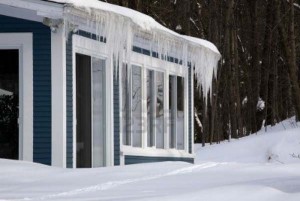Ask The Builder
Tim Carter just celebrated his 25th anniversary of his “Ask the Builder” syndicated newspaper column. When I began writing “Ask the Pole Barn Guru”, I was unaware of Tim and his column.
To commemorate this event, Tim penned this article: http://www.spokesman.com/stories/2018/sep/29/ask-the-builder-reflections-on-25-years-writing-ab/.
There are some highlights of Mr. Carter’s I totally agree with and would like to expound upon.
“I’ve seen many good things happen over the past 25 years with respect to building products, and I’ve seed disturbing trends emerge with respect to product longevity and the quality produced by tradespeople who build your new homes and additions, and who install new roofs.
The straw that broke the camel’s back at my house was asphalt shingles. My 30-year-warranty asphalt shingles started to go bad in just 10 years, and I had to replace them a few years later. I was so upset I wrote an expose book, “Roofing Ripoff,” that explains why your roof and mine are falling apart long before they should – and, most importantly, how to avoid premature shingle failure. It’s my opinion that ethics seem to be in short supply, or missing, in the boardrooms of certain manufacturers.
 Perhaps the most disturbing trend of all is workmanship quality. One could write a book on all the possible causes, but first and foremost is the removal of the incentive in high school for young people to choose a trade as a rewarding career path. That’s a grave mistake, in my opinion, and you and millions of others are paying for it by dealing with more and more inept, uninspired tradespeople, who seemingly are the new normal.
Perhaps the most disturbing trend of all is workmanship quality. One could write a book on all the possible causes, but first and foremost is the removal of the incentive in high school for young people to choose a trade as a rewarding career path. That’s a grave mistake, in my opinion, and you and millions of others are paying for it by dealing with more and more inept, uninspired tradespeople, who seemingly are the new normal.
If I could wave a magic wand right now, I’d make two things happen. I’d bring back and expand all of the vocational school programs. Home building, as well as all trades, would be encouraged as a career as early as grade school.
I’d also make ethics a mandatory course in high school and college, and a core topic at all business schools. The quest for higher and higher profits seems to put far too much pressure on the ethical aspects of business.”
For $19.95, you can own Tim’s book (https://www.amazon.com/Roofing-Ripoff-Asphalt-Shingles-Falling-ebook/dp/B06Y4XWLB2).
Being realistic, roofing manufacturer’s write their warranties to protect themselves, not consumers. Most roof shingle warranties come with some sort of prorated terms. For instance, many warranties will feature a labor and materials replacement cost for first year or some short term up to five and sometimes 10 years. Terms vary but often cover the price of new shingles and a fixed labor rate per 100 square feet of shingles. However, most of them hardly ever cover cost of removing damaged shingles, disposal, fasteners, flashing, vents or other miscellaneous roofing materials.
After the initial period, warranty typically only covers a prorated cost of shingles based upon roof age. So it’s very possible to end up with a roof only five years old with a defective shingle where replacement cost might be $5,000 and you only qualify for $500 based upon warranty.
Real kicker, labor runs 60% to 80% of a roofing job and not shingle cost. Furthermore, most roofing contractors are only going to warranty their workmanship and not labor associated with a manufacturer’s defect.
Considering shingles for your new post frame building? Stop and think twice. Steel roofing will be most affordable and more durable.
When I was in school, my Dad being a builder was cool with my friends – because building contractors then had a reputation for doing quality workmanship. In today’s world, over half of all contractors did not graduate high school. If you are lucky enough to hire a “good one” all-to-often workmanship provided was just enough to get by.
Sadly, it appears fewer and fewer new post frame building clients are willing to attempt doing their own work – even though doing it themselves will most often result in a far better end result. When it’s YOUR building, you care enough to do things carefully and “right”.
 In areas where there has been a history of ice forming along the eaves causing a backup of water, an ice barrier that consists of at least two layers of underlayment cemented together or of a self-adhering polymer modified bitumen sheet shall be used in lieu of normal underlayment and extend from the lowest edges of all roof surfaces to a point at least 24 inches inside the exterior wall line of the building.”
In areas where there has been a history of ice forming along the eaves causing a backup of water, an ice barrier that consists of at least two layers of underlayment cemented together or of a self-adhering polymer modified bitumen sheet shall be used in lieu of normal underlayment and extend from the lowest edges of all roof surfaces to a point at least 24 inches inside the exterior wall line of the building.” Perhaps the most disturbing trend of all is workmanship quality. One could write a book on all the possible causes, but first and foremost is the removal of the incentive in high school for young people to choose a trade as a rewarding career path. That’s a grave mistake, in my opinion, and you and millions of others are paying for it by dealing with more and more inept, uninspired tradespeople, who seemingly are the new normal.
Perhaps the most disturbing trend of all is workmanship quality. One could write a book on all the possible causes, but first and foremost is the removal of the incentive in high school for young people to choose a trade as a rewarding career path. That’s a grave mistake, in my opinion, and you and millions of others are paying for it by dealing with more and more inept, uninspired tradespeople, who seemingly are the new normal.





